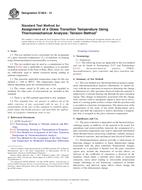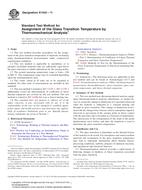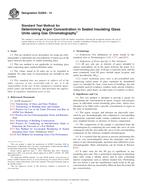Potřebujeme váš souhlas k využití jednotlivých dat, aby se vám mimo jiné mohly ukazovat informace týkající se vašich zájmů. Souhlas udělíte kliknutím na tlačítko „OK“.
ASTM E1824-13
Standard Test Method for Assignment of a Glass Transition Temperature Using Thermomechanical Analysis: Tension Method
Automaticky přeložený název:
Standardní zkušební metoda pro postoupení teplotu skelného přechodu Použití termomechanická analýza: Napětí Method
NORMA vydána dne 1.8.2013
Informace o normě:
Označení normy: ASTM E1824-13
Poznámka: NEPLATNÁ
Datum vydání normy: 1.8.2013
Kód zboží: NS-43212
Počet stran: 4
Přibližná hmotnost: 12 g (0.03 liber)
Země: Americká technická norma
Kategorie: Technické normy ASTM
Kategorie - podobné normy:
Anotace textu normy ASTM E1824-13 :
Keywords:
glass transition, glass transition temperature, Tg, tensile mode, thermomechanical analysis (TMA), thermodilatometry, ICS Number Code 17.200.10 (Heat. Calorimetry)
Doplňující informace
| Significance and Use | ||||||||
|
5.1 The glass transition is dependent on the thermal history, softening agents or additives of the material to be tested. For amorphous and semicrystalline materials the assignment of a glass transition temperature may lead to important information about thermal history, processing conditions, stability, progress of chemical reactions, and mechanical and electrical behavior. 5.2 Thermomechanical analysis provides a rapid means of detecting changes in hardness or linear dimensional change associated with the glass transition. Dimensional changes measured as a specimen is heated over the glass transition region may include the interaction of several effects: an increase in the coefficient of expansion, a decrease in the modulus, which under a constant stress leads to increased extension, stress relief leading to irreversible dimensional change (shrinkage in one dimension, expansion in another dimension), and physical aging effects which change the kinetics of the dimensional change. 5.3 This test method is useful for research and development, quality control, and specification acceptance testing; particularly of films and fibers. |
||||||||
| 1. Scope | ||||||||
|
1.1 This test method covers a procedure for the assignment of a glass transition temperature (Tg) of materials on heating using thermomechanical measurements in tension. 1.2 This test method may be used as a complement to Test Method E1545 and is applicable to amorphous or to partially crystalline materials in the form of films, fibers, wires, etc., that are sufficiently rigid to inhibit extension during loading at ambient temperature. 1.3 The generally applicable temperature range for this test method is −100 to 600°C. This temperature range may be altered depending upon the instrumentation used. 1.4 The values stated in SI units are to be regarded as standard. No other units of measurement are included in this standard. 1.5 There is no ISO method equivalent to this standard. 1.6 This standard does not purport to address all of the safety concerns, if any, associated with its use. It is the responsibility of the user of this standard to establish appropriate safety and health practices and determine the applicability of regulatory limitations prior to use. |
||||||||
| 2. Referenced Documents | ||||||||
|
Podobné normy:
Historická
1.10.2013
Historická
1.4.2011
Historická
1.12.2011
Historická
1.11.2010
Historická
1.4.2014
Historická
1.10.2013



 ASTM C912-93(2013)..
ASTM C912-93(2013).. ASTM E1545-11
ASTM E1545-11 ASTM E1967-11a
ASTM E1967-11a ASTM E2188-10
ASTM E2188-10 ASTM E2269-14
ASTM E2269-14 ASTM F218-13
ASTM F218-13
 Cookies
Cookies
